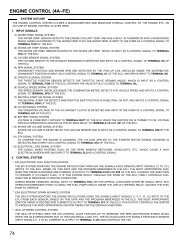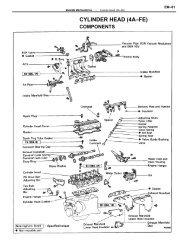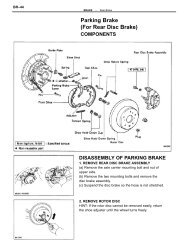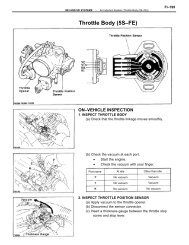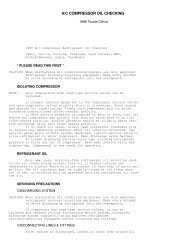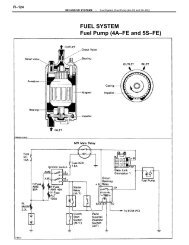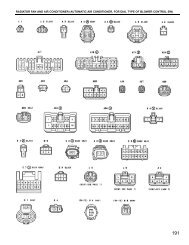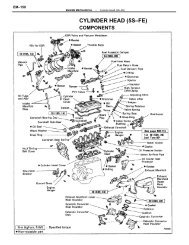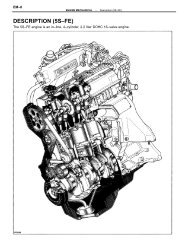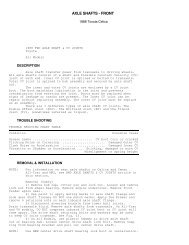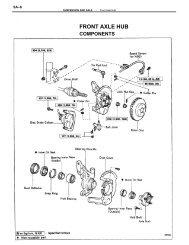Engine cooling fan - 2.2l 4-cyl - CelicaTech
Engine cooling fan - 2.2l 4-cyl - CelicaTech
Engine cooling fan - 2.2l 4-cyl - CelicaTech
Create successful ePaper yourself
Turn your PDF publications into a flip-book with our unique Google optimized e-Paper software.
ENGINE COOLING FAN - 2.2L 4-CYL<br />
1994 Toyota Celica<br />
1994 ENGINE COOLING<br />
Toyota <strong>Engine</strong> Cooling Fans<br />
Celica 2.2L 4<br />
Cyl<br />
ELECTRIC COOLING FAN<br />
NOTE: Electric <strong>cooling</strong> <strong>fan</strong> may be used for radiator or condenser.<br />
To verify electric <strong>cooling</strong> location and application, see<br />
ELECTRIC COOLING FAN IDENTIFICATION table. For condenser<br />
<strong>cooling</strong> <strong>fan</strong> testing, see the A/C-HEATER SYSTEM article.<br />
ELECTRIC COOLING FAN IDENTIFICATION TABLE<br />
¡¡¡¡¡¡¡¡¡¡¡¡¡¡¡¡¡¡¡¡¡¡¡¡¡¡¡¡¡¡¡¡¡¡¡¡¡¡¡¡¡¡¡¡¡¡¡¡¡¡¡¡¡¡¡¡¡¡¡¡¡¡¡¡¡¡¡¡<br />
¡<br />
Application<br />
Cooling Fan Identification<br />
Condenser Cooling Fan ............ Passenger’s Side Rear Of Radiator<br />
Radiator Cooling Fan ................ Driver’s Side Rear Of Radiator<br />
¡ ¡ ¡ ¡ ¡ ¡ ¡ ¡ ¡ ¡ ¡ ¡ ¡ ¡ ¡ ¡ ¡ ¡ ¡ ¡ ¡ ¡ ¡ ¡ ¡ ¡ ¡ ¡ ¡ ¡ ¡ ¡ ¡ ¡ ¡ ¡ ¡ ¡ ¡ ¡ ¡ ¡ ¡ ¡ ¡ ¡ ¡ ¡ ¡ ¡ ¡ ¡ ¡ ¡ ¡ ¡ ¡ ¡ ¡ ¡ ¡ ¡ ¡ ¡ ¡ ¡ ¡ ¡ ¡<br />
RADIATOR COOLING FAN SYSTEM TEST<br />
NOTE: On A/C equipped models, an A/C high-pressure switch may be<br />
used in conjunction with <strong>cooling</strong> <strong>fan</strong> relays for controlling<br />
of radiator <strong>cooling</strong> <strong>fan</strong>. See the A/C-HEATER SYSTEM article<br />
for additional information.<br />
1) Ensure engine coolant temperature is less than specified<br />
STEP 1 temperature. See RADIATOR COOLING FAN SYSTEM TESTING<br />
TEMPERATURE SPECIFICATIONS table. Turn ignition on. Ensure radiator<br />
<strong>cooling</strong> <strong>fan</strong> stops.<br />
2) If radiator <strong>cooling</strong> <strong>fan</strong> stops, proceed to step 5). If<br />
radiator <strong>cooling</strong> <strong>fan</strong> operates, check <strong>cooling</strong> <strong>fan</strong> relay No. 1 and<br />
<strong>Engine</strong> Coolant Temperature (ECT) switch. See COOLING FAN RELAY NO. 1<br />
and ENGINE COOLANT TEMPERATURE (ECT) SWITCH under COMPONENT TESTING.<br />
3) If <strong>cooling</strong> <strong>fan</strong> relay No. 1 and ECT switch are okay, check<br />
for open circuit in wire between ECT switch and <strong>cooling</strong> <strong>fan</strong> relay No.<br />
1. Consult appropriate wiring diagram if necessary. See WIRING<br />
DIAGRAMS.<br />
4) Cooling <strong>fan</strong> relay No. 1 is located in fuse/relay box. For<br />
ECT switch locations, see ECT SWITCH LOCATIONS table.<br />
5) With ignition on, disconnect electrical connector at<br />
<strong>Engine</strong> Coolant Temperature (ECT) switch. For ECT switch locations, see<br />
ECT SWITCH LOCATIONS table. Ensure radiator <strong>cooling</strong> <strong>fan</strong> operates.<br />
6) If radiator <strong>cooling</strong> <strong>fan</strong> operates, proceed to step 9). If<br />
radiator <strong>cooling</strong> <strong>fan</strong> does not operate, check <strong>cooling</strong> <strong>fan</strong> relay No. 1,<br />
radiator <strong>cooling</strong> <strong>fan</strong>, engine or <strong>fan</strong> main relay and necessary fuses.<br />
7) Consult appropriate wiring diagram for proper fuse<br />
applications. See WIRING DIAGRAMS. See COOLING FAN RELAY NO. 1,<br />
RADIATOR COOLING FAN, FAN MAIN RELAY and ENGINE MAIN RELAY under<br />
COMPONENT TESTING.<br />
8) If all components are okay, check for short circuit in<br />
wire between <strong>cooling</strong> <strong>fan</strong> relay No. 1 and ECT switch. Consult<br />
appropriate wiring diagram if necessary. See WIRING DIAGRAMS.<br />
9) Install electrical connector on ECT switch. Start engine.<br />
Warm engine until coolant temperature is greater than specified STEP 2<br />
temperature. See RADIATOR COOLING FAN SYSTEM TESTING TEMPERATURE<br />
SPECIFICATIONS table.<br />
10) Ensure radiator <strong>cooling</strong> <strong>fan</strong> operates. Replace ECT switch
¢<br />
¢<br />
¢<br />
¢<br />
¢<br />
¢<br />
¢<br />
¢<br />
¢<br />
if radiator <strong>cooling</strong> <strong>fan</strong> fails to operate and recheck operation.<br />
RADIATOR COOLING FAN SYSTEM TESTING TEMPERATURE SPECIFICATIONS TABLE<br />
¢<br />
Application Step 1 Temp. Step 2 Temp.<br />
F ( C)<br />
F ( C)<br />
¡ ¡ ¡ ¡ ¡ ¡ ¡ ¡ ¡ ¡ ¡ ¡ ¡ ¡ ¡ ¡ ¡ ¡ ¡ ¡ ¡ ¡ ¡ ¡ ¡ ¡ ¡ ¡ ¡ ¡ ¡ ¡ ¡ ¡ ¡ ¡ ¡ ¡ ¡ ¡ ¡ ¡ ¡ ¡ ¡ ¡ ¡ ¡ ¡ ¡ ¡ ¡ ¡ ¡ ¡ ¡ ¡ ¡ ¡ ¡ ¡ ¡ ¡ ¡ ¡ ¡ ¡ ¡ ¡<br />
Celica Without A/C ......... 181 (83) ................... 199 (93)<br />
¡ ¡ ¡ ¡ ¡ ¡ ¡ ¡ ¡ ¡ ¡ ¡ ¡ ¡ ¡ ¡ ¡ ¡ ¡ ¡ ¡ ¡ ¡ ¡ ¡ ¡ ¡ ¡ ¡ ¡ ¡ ¡ ¡ ¡ ¡ ¡ ¡ ¡ ¡ ¡ ¡ ¡ ¡ ¡ ¡ ¡ ¡ ¡ ¡ ¡ ¡ ¡ ¡ ¡ ¡ ¡ ¡ ¡ ¡ ¡ ¡ ¡ ¡ ¡ ¡ ¡ ¡ ¡ ¡<br />
ECT SWITCH LOCATIONS TABLE<br />
¡¡¡¡¡¡¡¡¡¡¡¡¡¡¡¡¡¡¡¡¡¡¡¡¡¡¡¡¡¡¡¡¡¡¡¡¡¡¡¡¡¡¡¡¡¡¡¡¡¡¡¡¡¡¡¡¡¡¡¡¡¡¡¡¡¡¡¡<br />
¡<br />
Application<br />
(1) Switch Location<br />
Celica<br />
2.2L (5S-FE) ................................... Bottom Of Radiator<br />
(1) - For additional information on ECT switch locations.<br />
¡ ¡ ¡ ¡ ¡ ¡ ¡ ¡ ¡ ¡ ¡ ¡ ¡ ¡ ¡ ¡ ¡ ¡ ¡ ¡ ¡ ¡ ¡ ¡ ¡ ¡ ¡ ¡ ¡ ¡ ¡ ¡ ¡ ¡ ¡ ¡ ¡ ¡ ¡ ¡ ¡ ¡ ¡ ¡ ¡ ¡ ¡ ¡ ¡ ¡ ¡ ¡ ¡ ¡ ¡ ¡ ¡ ¡ ¡ ¡ ¡ ¡ ¡ ¡ ¡ ¡ ¡ ¡ ¡<br />
COMPONENT TESTING<br />
CAUTION: When battery is disconnected, vehicle computer and memory<br />
systems may lose memory data. Driveability problems may<br />
exist until computer systems have completed a relearn cycle.<br />
A/C AMPLIFIER CIRCUIT TEST TABLE<br />
¡¡¡¡¡¡¡¡¡¡¡¡¡¡¡¡¡¡¡¡¡¡¡¡¡¡¡¡¡¡¡¡¡¡¡¡¡¡¡¡¡¡¡¡¡¡¡¡¡¡¡¡¡¡¡¡¡¡¡¡¡¡¡¡¡¡¡¡<br />
¡<br />
Wiring Harness<br />
Terminals Condition Specification<br />
No. 3 & Ground ............... .... ................... Continuity<br />
No. 4 & Ground ............ Ignition On .......... Battery Voltage<br />
No. 9 & 15 .............. 185 F (85 C) (1) ............. 1350 Ohms<br />
No. 9 & 15 .............. 194 F (90 C) (1) ............. 1190 Ohms<br />
No. 9 & 15 .............. 203 F (95 C) (1) ............. 1050 Ohms<br />
No. 10 & Ground ........... Ignition On .......... Battery Voltage<br />
No. 13 & Ground .............. .... ................... Continuity<br />
(1) - This is the coolant temperature.<br />
¡ ¡ ¡ ¡ ¡ ¡ ¡ ¡ ¡ ¡ ¡ ¡ ¡ ¡ ¡ ¡ ¡ ¡ ¡ ¡ ¡ ¡ ¡ ¡ ¡ ¡ ¡ ¡ ¡ ¡ ¡ ¡ ¡ ¡ ¡ ¡ ¡ ¡ ¡ ¡ ¡ ¡ ¡ ¡ ¡ ¡ ¡ ¡ ¡ ¡ ¡ ¡ ¡ ¡ ¡ ¡ ¡ ¡ ¡ ¡ ¡ ¡ ¡ ¡ ¡ ¡ ¡ ¡ ¡<br />
Cooling Fan Relay No. 1<br />
1) Disconnect negative battery cable. Remove <strong>cooling</strong> <strong>fan</strong><br />
relay No. 1 relay from fuse/relay box. Using ohmmeter, ensure<br />
continuity exists between specified terminals. See Fig. 1.<br />
2) To check relay operation, connect battery to specified<br />
terminals of <strong>cooling</strong> <strong>fan</strong> relay No. 1. See Fig. 1. Using ohmmeter,<br />
ensure no continuity exists between specified terminals. See Fig. 1.<br />
Replace <strong>cooling</strong> <strong>fan</strong> relay No. 1 if defective.
Fig. 1: Testing Cooling Fan Relay No. 1<br />
Courtesy of Toyota Motor Sales, U.S.A., Inc.<br />
Cooling Fan Relay No. 2<br />
1) Disconnect negative battery cable. Remove <strong>cooling</strong> <strong>fan</strong>
elay No. 2 relay from fuse/relay box. Using ohmmeter, ensure<br />
continuity and no continuity exists between specified terminals. See<br />
Fig. 2.<br />
2) To check relay operation, connect battery to specified<br />
terminals of <strong>cooling</strong> <strong>fan</strong> relay No. 2. See Fig. 2. Using ohmmeter,<br />
ensure continuity and no continuity exists between specified<br />
terminals. See Fig. 2. Replace <strong>cooling</strong> <strong>fan</strong> relay No. 2 if defective.<br />
Fig. 2: Testing Cooling Fan Relay No. 2<br />
Courtesy of Toyota Motor Sales, U.S.A., Inc.<br />
Cooling Fan Relay No. 3<br />
1) Disconnect negative battery cable. Remove <strong>cooling</strong> <strong>fan</strong>
elay No. 3 relay from fuse/relay box. Using ohmmeter, ensure<br />
continuity and no continuity exists between specified terminals. See<br />
Fig. 3.<br />
2) To check relay operation, connect battery to specified<br />
terminals of <strong>cooling</strong> <strong>fan</strong> relay No. 3. See Fig. 3. Using ohmmeter,<br />
ensure continuity exists between specified terminals. See Fig. 3.<br />
Replace <strong>cooling</strong> <strong>fan</strong> relay No. 3 if defective.<br />
Fig. 3: Testing Cooling Fan Relay No. 3<br />
Courtesy of Toyota Motor Sales, U.S.A., Inc.<br />
COOLING FAN CONTROL MODULE CIRCUIT TEST TABLE<br />
¡ ¡ ¡ ¡ ¡ ¡ ¡ ¡ ¡ ¡ ¡ ¡ ¡ ¡ ¡ ¡ ¡ ¡ ¡ ¡ ¡ ¡ ¡ ¡ ¡ ¡ ¡ ¡ ¡ ¡ ¡ ¡ ¡ ¡ ¡ ¡ ¡ ¡ ¡ ¡ ¡ ¡ ¡ ¡ ¡ ¡ ¡ ¡ ¡ ¡ ¡ ¡ ¡ ¡ ¡ ¡ ¡ ¡ ¡ ¡ ¡ ¡ ¡ ¡ ¡ ¡ ¡ ¡ ¡
¢<br />
¢<br />
¢<br />
¢<br />
¢<br />
¢<br />
¢<br />
¢<br />
¢<br />
¢<br />
Wiring Harness Condition Specification<br />
Terminals<br />
No. 1 & Ground ............... .... ................... Continuity<br />
No. 2 & Ground ............ Ignition On .......... Battery Voltage<br />
No. 3 & Ground ............ Ignition On .......... Battery Voltage<br />
No. 5 & 6 ............... 68 F (20 C) (1) .............. 2450 Ohms<br />
No. 5 & 6 .............. 136 F (58 C) (1) .............. 630 Ohms<br />
No. 5 & 6 .............. 176 F (80 C) (1) .............. 320 Ohms<br />
No. 7 & Ground ............ Ignition On .......... Battery Voltage<br />
No. 9 & Ground ............ Ignition On .......... Battery Voltage<br />
(1) - This is the engine compartment temperature.<br />
¡ ¡ ¡ ¡ ¡ ¡ ¡ ¡ ¡ ¡ ¡ ¡ ¡ ¡ ¡ ¡ ¡ ¡ ¡ ¡ ¡ ¡ ¡ ¡ ¡ ¡ ¡ ¡ ¡ ¡ ¡ ¡ ¡ ¡ ¡ ¡ ¡ ¡ ¡ ¡ ¡ ¡ ¡ ¡ ¡ ¡ ¡ ¡ ¡ ¡ ¡ ¡ ¡ ¡ ¡ ¡ ¡ ¡ ¡ ¡ ¡ ¡ ¡ ¡ ¡ ¡ ¡ ¡ ¡<br />
<strong>Engine</strong> Coolant Temperature (ECT) Switch (2.2L 5S-FE)<br />
1) Disconnect negative battery cable. Drain <strong>cooling</strong> system.<br />
Disconnect electrical connector and remove ECT switch. See ECT SWITCH<br />
LOCATIONS table. Place probe end of ECT switch in container of water.<br />
2) Using ohmmeter, check for continuity and then no<br />
continuity between electrical terminals on ECT switch while heating<br />
water to specified temperatures. See ECT SWITCH CONTINUITY<br />
SPECIFICATIONS table.<br />
3) Replace ECT switch if not as specified. Reinstall ECT<br />
switch using NEW "O" ring (if equipped). Fill <strong>cooling</strong> system.<br />
ECT SWITCH LOCATIONS TABLE<br />
¡¡¡¡¡¡¡¡¡¡¡¡¡¡¡¡¡¡¡¡¡¡¡¡¡¡¡¡¡¡¡¡¡¡¡¡¡¡¡¡¡¡¡¡¡¡¡¡¡¡¡¡¡¡¡¡¡¡¡¡¡¡¡¡¡¡¡¡<br />
¡<br />
Application<br />
(1) Switch Location<br />
Celica<br />
2.2L (5S-FE) ................................... Bottom Of Radiator<br />
(1) - For additional information on ECT switch locations.<br />
¡ ¡ ¡ ¡ ¡ ¡ ¡ ¡ ¡ ¡ ¡ ¡ ¡ ¡ ¡ ¡ ¡ ¡ ¡ ¡ ¡ ¡ ¡ ¡ ¡ ¡ ¡ ¡ ¡ ¡ ¡ ¡ ¡ ¡ ¡ ¡ ¡ ¡ ¡ ¡ ¡ ¡ ¡ ¡ ¡ ¡ ¡ ¡ ¡ ¡ ¡ ¡ ¡ ¡ ¡ ¡ ¡ ¡ ¡ ¡ ¡ ¡ ¡ ¡ ¡ ¡ ¡ ¡ ¡<br />
ECT SWITCH CONTINUITY SPECIFICATIONS TABLE<br />
¡¡¡¡¡¡¡¡¡¡¡¡¡¡¡¡¡¡¡¡¡¡¡¡¡¡¡¡¡¡¡¡¡¡¡¡¡¡¡¡¡¡¡¡¡¡¡¡¡¡¡¡¡¡¡¡¡¡¡¡¡¡¡¡¡¡¡¡<br />
¡<br />
Application<br />
Temperature<br />
Celica Without A/C<br />
Continuity ................................. Less Than 181<br />
No Continuity ........................... Greater Than 199<br />
F (83<br />
F (93<br />
C)<br />
C)<br />
¡ ¡ ¡ ¡ ¡ ¡ ¡ ¡ ¡ ¡ ¡ ¡ ¡ ¡ ¡ ¡ ¡ ¡ ¡ ¡ ¡ ¡ ¡ ¡ ¡ ¡ ¡ ¡ ¡ ¡ ¡ ¡ ¡ ¡ ¡ ¡ ¡ ¡ ¡ ¡ ¡ ¡ ¡ ¡ ¡ ¡ ¡ ¡ ¡ ¡ ¡ ¡ ¡ ¡ ¡ ¡ ¡ ¡ ¡ ¡ ¡ ¡ ¡ ¡ ¡ ¡ ¡ ¡ ¡<br />
<strong>Engine</strong> Main Relay<br />
1) Disconnect negative battery cable. Remove engine main<br />
relay from fuse/relay box. Using ohmmeter, ensure continuity and no<br />
continuity exists between specified terminals. See Fig. 4.<br />
2) To check relay operation, connect battery to specified<br />
terminals of engine main relay. See Fig. 4. Using ohmmeter, ensure<br />
continuity and no continuity exists between specified terminals. See<br />
Fig. 4. Replace engine main relay if defective.
Fig. 4: Testing <strong>Engine</strong> Main Relay<br />
Courtesy of Toyota Motor Sales, U.S.A., Inc.<br />
Radiator Cooling Fan<br />
1) Disconnect electrical connector from radiator <strong>cooling</strong> <strong>fan</strong>.
Connect battery and ammeter to electrical connector on radiator<br />
<strong>cooling</strong> <strong>fan</strong>.<br />
2) Radiator <strong>cooling</strong> <strong>fan</strong> should operate smoothly and amperage<br />
draw should be within specification. See RADIATOR COOLING FAN AMPERAGE<br />
DRAW SPECIFICATIONS table.<br />
3) Replace radiator <strong>cooling</strong> <strong>fan</strong> if it fails to rotate<br />
smoothly or amperage draw is not within specification. Reinstall<br />
electrical connector.<br />
RADIATOR COOLING FAN AMPERAGE DRAW SPECIFICATIONS TABLE<br />
¡¡¡¡¡¡¡¡¡¡¡¡¡¡¡¡¡¡¡¡¡¡¡¡¡¡¡¡¡¡¡¡¡¡¡¡¡¡¡¡¡¡¡¡¡¡¡¡¡¡<br />
¡<br />
Application<br />
Amps<br />
Celica<br />
2.2L (5S-FE) ............................ 5.7-7.7<br />
¡ ¡ ¡ ¡ ¡ ¡ ¡ ¡ ¡ ¡ ¡ ¡ ¡ ¡ ¡ ¡ ¡ ¡ ¡ ¡ ¡ ¡ ¡ ¡ ¡ ¡ ¡ ¡ ¡ ¡ ¡ ¡ ¡ ¡ ¡ ¡ ¡ ¡ ¡ ¡ ¡ ¡ ¡ ¡ ¡ ¡ ¡ ¡ ¡ ¡ ¡<br />
WIRING DIAGRAMS<br />
Fig. 5: Electric Cooling Fan Wiring Diagram



